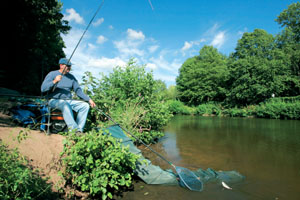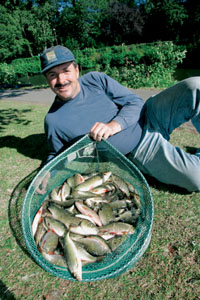| It’s free to fish and offers high quality summer roach fishing. |
 |
AS you walk along the footpath that runs beside the clear water of the River Tone in
These are the species that have made the river one of the favourite southwest venues for large numbers of pleasure and match anglers. With the prospect of silver fish bags regularly over 20lb and, when the water really is on song, 70lb red-letter days, you can’t blame ’em, can you?
Quality roach
Much of the fishing on the Tone is controlled by the Taunton Angling Associa-tion, and while they have some fine waters on their books it is the free stretch near the town centre that Russ Tinklin is con-centrating on and, in particular, the upstream section from the bridge at Bridge Street.
Here the river runs through a mixture of parkland and urban sprawl but it is a gem of a fishery. This is where we met up with the Thatcher’s 2000 star who has fished the stretch on and off for the past 12 years.
“It hasn’t really changed much in all that time,” says Russ. “Although there used to be a really good head of 1lb-plus roach they are not so common now, but you can still catch plenty of good-quality roach to 1lb.
“Dace have made a comeback in the last couple of years and the venue has always been noted for its good nets of chub,” he adds. “I’ve had 40lb bags of chub and 20lb nets of roach and, in fact, on many visits when the river is reasonable I’ve had 20lb of fish.
“Some days, catches can consist mostly of chub and on other days it could be mainly roach or even dace. On others it could be a right mix,” he continues. “There is also the odd grayling to be had, and you will probably hook a trout as well. There are big carp throughout the river but they will usually see you off,” he laughs.
“If you want to target the chub, you need to look for swims with plenty of cover but you don’t have to fish too close to it. As long as you keep feeding regularly they’ll keep moving out into the main river.
“Generally when you get good bags of mostly chub the action comes in bursts, or you catch well for, say, a couple of hours,” revealed Russ.
Waggler line
Flow is the key to a successful session on the Tone. On this visit the river was obviously quite sluggish. When the water is in this condition some areas are virtually still. It is important to find the area with the most flow, as this is where there will be the greater dissolved oxygen content and where you would expect to find a larger concentration of fish.
Just above the swim that Russ had selected, the flow comes from his inside of the river and cuts across towards the far bank, giving around six to seven metres of very slow and quite shallow water in front of him.
A quick assessment of the swim dictated that Russ’ main line of attack was going to be the waggler, as a running line would enable him to reach the far side of the river, where the flow was at it’s quickest, easily.
His second line is the edge of the flow closest to him where a pole fished at nine metres would reach the prominent crease.
Choice of baits for the venue are varied where hemp and tares will work very well through the late summer and into autumn, but perhaps the most reliable baits are maggots and casters, although the former can be a problem with minnows. So casters are the better choice.
Waggler rigs
The waggler rod is normally the first out of Russ’ bag, especially if the main flow is across the far side of the river. This method also allows him to reach the far-bank cover, and while chub like the security this offers, they can be encouraged out into mid-river by regular feeding.
Through the summer and autumn months the best tactic, whether on the pole or waggler, is to fish off the bottom.
When firing a little feed into the river, you will see fish instantly move onto it and often in the top few inches of water. For this reason it is important to set the waggler very shallow as it can prove to be a highly effective tactic.
“I always set up two waggler rigs,” says Russ. “The first uses a light 3BB waggler on 21/2lb Preston Innovations Direct Mono reel line. To this I tie a 0.10mm hooklength. The bulk of my shot is attached around the bottom of the float, apart from two No12 droppers spread out down the line. “The whole rig is set two to three feet deep so that it will slowly sink through the water, as I hope to catch on the drop near the surface,” he explains. My choices of hook are a size 18 for casters or a 20 or 24 for maggots. I find the Kamasan B520 hook is an ideal pattern for this venue.
“For fishing deeper, I use a 2AAA waggler with my shot spread out evenly from the float to the hook and set to run through at depth,” says Russ. “This rig picks up any flow in the river. There are days when the fish refuse to feed well on or near the surface. Dull weather, if there’s extra flow or when there is a downstream wind, are all occasions when this deep set-up can outscore the shallow one,” he adds. “On this rig I use 2lb Direct Mono and, if the conditions dictate, I am prepared to drop down to a 0.08mm hooklength for the roach.”
| Russ with a 20lb bag of silver from the Tone. |
 |
Sensitive rigs
For his pole line Russ chooses a rig with a slim-bodied pole float for the day’s calmer conditions, but would use one with a more rounded pattern for when there is more flow in the river or in windier conditions.
“A slim float is more sensitive in the slower flow,” he explains.
Russ intends to fish this rig on the drop, so his shotting pattern is a number of No10s and No12s strung out down the line. The rig can also be used to fish off the bottom and he sets this one 12 inches off the riverbed in four and a half feet of water.
With this sensitive rig Russ fishes with a lot of the fine bristle showing out of the water because he is liable to get line bites from fish darting around as they chase his loose feed. When he gets a proper bite the whole bristle disappears, so that he knows that is the time to strike.
With the river being so clear he uses a long line with four to five feet of it between pole tip and float. This keeps the pole tip away from the fish and is less likely to spook them than when using a shorter line.
To enable him to catch the smaller fish without bumping them off, and also land the bigger chub, Russ favours the 6-8 Middy Hi-Viz elastic used in a carp top kit. His pole rigs are made up on 0.12mm main line and if he is bagging he prefers a 0.10mm hooklength, otherwise its 0.08mm. Hooks are size 18 Kamasan B611s for normal work, stepping up to a size 16 for bagging up.
Instant reaction
“I’m starting on the shallow waggler across to the far side, about one metre or so off the far-bank cover,” says Russ. The best feeding policy is sprayed maggots, and I find that it is much better to feed first and then cast the waggler into the feed area. If the fish respond well, by feeding slightly shorter, I can draw the fish closer to me,” he adds.
“When this happens, it pays to cast well out first and then feed and drag the float back over the feed. Some days I can get away with it, some days I can’t,” he explains. “If the minnows become a nuisance I will start to feed hemp and casters on the waggler line.”
The action soon started and his waggler was dipping under regularly, usually due to an instant reaction from a dace or roach as soon as his bait broke through the tension of the surface.
These bites prove very difficult to hit, as among Russ’ target fish large numbers of minnows made nuisances of themselves.
“A double maggot is a good bait to start with, but I will have to drop to a single bait to keep the bites coming as the session progresses,” explains Russ.
He is regularly feeding his pole line. As it is only a short distance to the nearside flow, he feeds a trickle of a dozen grains of hemp and six casters by hand.
If he fishes a longer distance, a catapult with a mixture of casters and hemp would go into the pouch at the same time.
Hemp fish
A couple of hours on the waggler results in a small bag of fish, so Russ decides it’s time to have a look at his pole line. He is hoping to pick up some quality hemp fish on this line and starts with a single caster with the hook completely buried. He presents it 12 inches off bottom. “I like to fish with the hook buried into the bait,” says Russ. “I believe it does make a difference to the bites I get.”
It’s not long before he latches on to some quality roach, dace and small chub that have found his steady stream of loose feed. He soon begins to enjoy some good, consistent sport.
After about half an hour of small fish, Russ finally connects with a decent, 1lb-plus chub that tests his elastic by making three or four lunges before being guided over a waiting net.
The next hour sees Russ land plenty more roach and dace, plus a few more of the venue’s small chub on the casters. He now feels it’s time to switch and have a look on the ‘black gold’.
The change to hemp results in Russ bagging a couple of better 6oz roach and a similar-sized chub, but then the bites start to drop away.
“It seems that I get a couple of fish on the hemp and then have to switch back to the casters,” declares Russ, who explains that when the fish really do have the hemp a tare can be a far better hook bait.
In fact, while he likes to start off feeding the swim with hemp and casters, if he starts to catch only roach he is prepared to change his feed to hemp only. He also explains that there are days when he fails to have bites on the hemp, so he switches to feeding casters only.
“I think the clarity of the water combined with the lack of flow hasn’t helped the seed sport today,” he concludes.
The seed fishing may not have been as effective as Russ had hoped, but he still managed to put together a superb mixed bag of around 20lb.
Venue Fact File
River Tone, Bridge Street,
Contact: For information on the fishing, visit one of the local tackle shops
Day tickets: This stretch of river is free to fish but you will need an Environment Agency licence
Restrictions: None
Local tackle shop:
Nearby pub: The Wood Street Inn, Wood Street,




